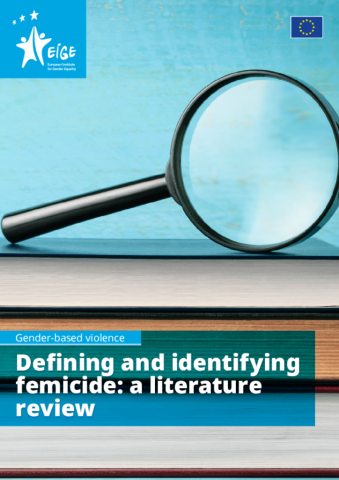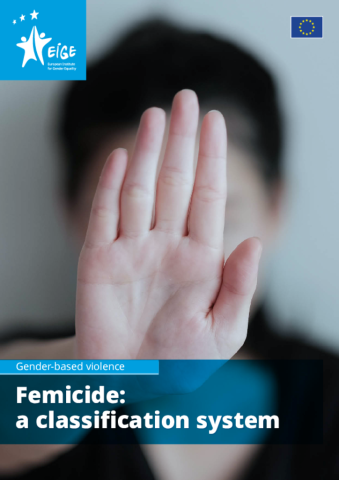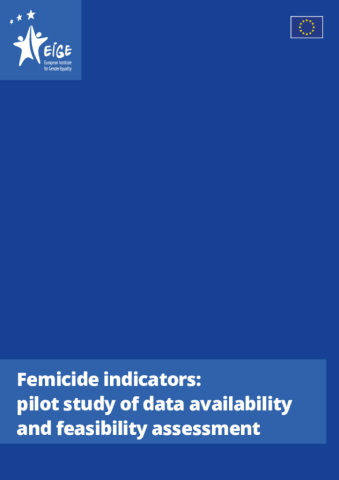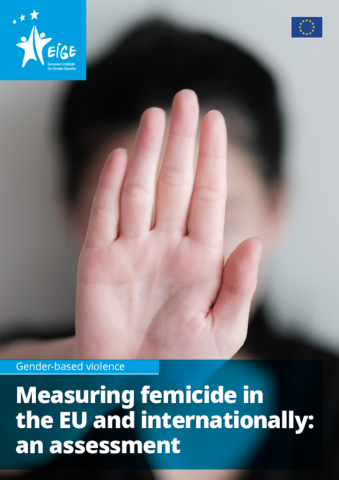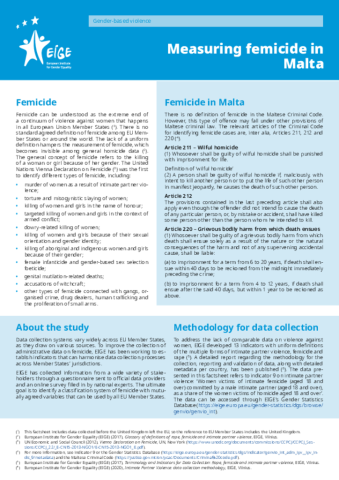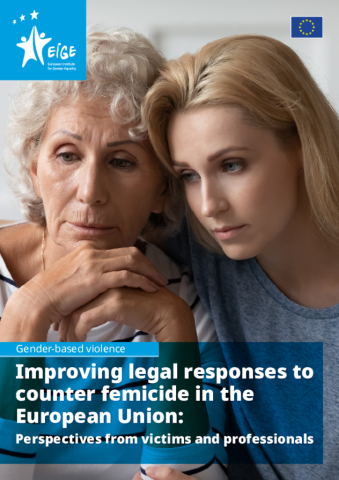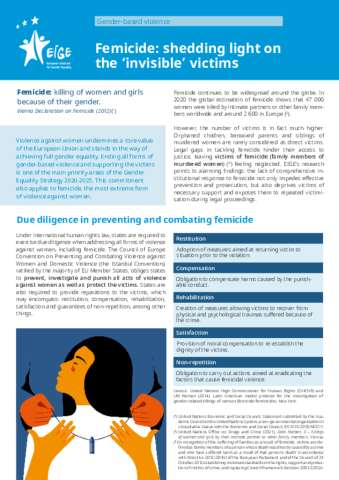Femicide is the most severe manifestation of gender-based violence.
It is deeply rooted in and a manifestation of power imbalances in society, which promotes an unequal status for men and women. Femicide is broadly defined as the killing of a woman or girl because of her gender, and can take different forms, such as the murder of women as a result of intimate partner violence; the torture and misogynist slaying of women; killing of women and girls in the name of “honour”; etc.
This section provides information about EIGE’s research initiatives on femicide.
EIGE supports Member States in their efforts to name femicide because the gender-neutral term of homicide overlooks the realities of inequality, oppression and systematic violence against women.
EIGE assists Member States in their efforts to count femicide because consistent and publicly available collection of administrative data is the first step towards preventing femicide..
EIGE conducts research on Member States’ legal responses to help them end femicide which requires effective prevention, thorough investigation, and diligent prosecution.
EIGE's publications on femicide
Name it
Count it
End it
More information about each study is available below.
Defining and identifying femicide: a literature review (2021)
This literature review provides a comparative analysis of definitions of, types of, indicators of and data collection systems on femicide in the EU and at international level.
This literature review:
- Detects descriptive variables or factors in a murder case to assess the demographic characteristics of the victim and perpetrators, the crime scene and the motivation for the killing.
- Offers an overview of the themes and challenges raised in the literature;
- Presents definitions of femicide, defines different types of femicide and reports variables used to identify femicide;
- Suggests administrative data that, if collected, might be used to establish a measurement framework for femicide.
The report sheds light on key problems in defining femicide, including poor data-collection systems, the invisibility of femicide as a result of underreporting, biases in data gathering and poor data governance.
The main types of femicide discussed in the literature are intimate partner femicide, sexual murder, femicide of women older than 65 and racist and homophobic femicide.
Based on the review, major descriptive variables for identifying femicide for statistical purposes have been identified.
Femicide: a classification system (2021)
The general concept of femicide can be articulated as gender-related killing (killing of a woman because she is a woman) in political, societal, criminal, sexual and interpersonal contexts:
EIGE presents a proposal of variables for a classification system that will help to standardise data gathering and contribute to a European Union-wide definition of femicide for statistical purposes:
Good policies need high-quality data that is based on agreed and clear definitions, recognised variables and common units of measurement and indicators.
EIGE is proposing to start a uniform data collection based on a shorter and more feasible classification of 12 types of intentional and unintentional femicide.
EIGE also conducted a pilot study among seven countries to assess the feasibility of populating the proposed indicators on femicide.
Measuring femicide in the EU and internationally: an assessment (2021)
This report gives a comprehensive overview of definitions, data collection systems, methodologies and variables in gathering data on femicide. It outlines whether and how different global and national actors are moving towards:
- a legal definition of femicide;
- construction of indicators / measurement framework based on common (agreed) variables to identify femicide.
The EU-27 have no definitions of femicide in the legal context, but killings of women are classified in several ways, including intentional homicide, non-intentional homicide and manslaughter. Some Member States introduced aggravated circumstances to better identify femicide, such as hatred, contempt or hostility towards a person on the grounds of sex; the gender-based violence connotation; or sexism, homicide of an intimate partner and sexual violence.
EIGE suggests some recommendations to enable Member States’ law enforcement institutions, judiciary and health organisations to gather sound and comparable data that can be translated into statistical data in a standardised way, that unveils the gender dimension of the killing of women and girls:
- A comparable working definition of femicide
- A minimum dataset
- Data governance and coordination
- A protocol for femicide
28 factsheets on the femicide framework in Member States
EIGE has developed 28 factsheets on the femicide framework in Member States.
Data collection systems vary widely across EU Member States, as they draw on various sources.
EIGE has collected information from a wide variety of stakeholders through a questionnaire sent to official data providers and an online survey filled in by national experts. Based on these EIGE is presenting country-factsheets with detailed information on the data gathering at national level.
End it
Improving legal responses to counter femicide (2023)
EIGE’s study “Improving legal responses to counter femicide” provides a comprehensive analysis of legal responses to counter femicide in the EU. Using the due diligence standard as a starting point, the study offers a holistic insight into the legal gaps, challenges and good practices in the provision of justice to victims of femicide.
The information was collected through desk research, a literature review and a comparative analysis of 109 interviews with professionals involved in femicide cases and victims family- members of a person whose death was directly caused by this crime - from five selected Member States: Germany, Spain, France, Portugal and Romania.
The policy recommendations focus on improving investigation, prosecution and sentencing in femicide cases, as well as on the role and rights of the victims, including their right to adequate compensation and comprehensive reparation. The report strengthens voices of victims by shifting the focus to their experiences, feelings, and highlighting whether existing legal provisions relating to different phases of criminal proceedings adequately protected their rights.
Read the factsheet Femicide: shedding light on the ‘invisible’ victims
